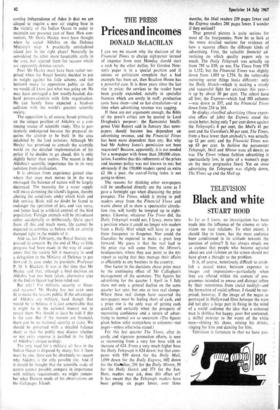Prices and incomes
THE PRESS DONALD McLACHLAN
I can see no reason why the decision of the Financial Times to charge eightpence instead
of sixpence from next Monday should start a rush by the other dailies. Sir Gordon New- ton's paper is in a special position and if unions or politicians complain that a bad example has been set, then Bracken House has a powerful case. It is three years since the last rise in price; the services to the reader have been greatly expanded, notably in specialist features which are costly in staff; production costs have risen—and so has circulation—at a time when advertising revenue was sagging.
If these are not arguments enough, the Bible of the press's critics can be quoted to Lord Drogheda's purpose: the Economist Intelli- gence Unit Report said in January that news- papers should become less dependent on
advertising revenue, and the Financial Times
has been more dependent than any. But why had Mr Aubrey Jones's permission not been requested? Because, apparently, it is not needed for a newspaper with fewer than 200,000 circu- lation. I confess that this refinement of the prices
and incomes policy was not known to me; but obviously if the 150,000 readers spend an extra f2 10s a year, the cost-of-living index is not going to shiver.
The reasons for thinking other newspapers will be unaffected directly are the same as I
gave a fortnight ago when discussing the price prospect. The Times, which is trying to pull readers away from the Financial Times and
wants above all to show a spectacular circula-
tion rise, will hardly be tempted up to eight- pence. Likewise, whatever The Times did, the Daily Telegraph would not, I fancy, move into a position where it could no longer win readers from a Daily Mail which will have to go up
from fourpence to fivepence. Nor could the
Guardian be expected to make a great leap forward. My guess is that the real lead to the price rise will come from the Mirror's headquarters, where they can point to the ETU report as saying that they manage their affairs as efficiently as any business in the country.
One factor in the decisions about price must be the continuing effect of Mr Callaghan's management of the economy. The figures for advertising for the quarter 1 April to 1 July show not only a general decline on the same quarter last year, but one or two real slumps.
Where these real slumps have occurred the newspapers must be feeling short of cash, and a price rise is the only way of getting cash quickly and certainly when the prospects of recovering confidence and a return of adver- tising to normal are so uncertain. (The figures given below refer everywhere to columns—not pages—unless otherwise stated.)
For this last quarter The Times, after its costly and vigorous promotion efforts, is seen
as recovering from a very low base with an
increase of 624. From a very much higher base the Daily Telegraph is 624 down; but that com- pares with 950 down for the Daily Mail, 1,099 down for the Daily Express, 602 down for the Guardian, 291 for the Daily Mirror, 59 for the Daily Sketch and 371 for the Sun. How, readers may ask, does this affect us? It has meant that the Telegraph readers have been getting six pages fewer, over three months, the Mail readers 239 pages fewer and the Express readers 286 pages fewer. I wonder if they noticed?
That general picture is quite serious for most of the fourpennies. Now let us look at the more detailed sections for evidence of how a squeeze affects the different kinds of advertising. First, the valuable financial ad- vertising on which quality papers rely so much. The Daily Telegraph was actually up from 795 to 839; so was The Times from 978 to 1,152; but the Financial Times was slightly down from 1,805 to 1,754. In the vulnerable motoring sector things looks different: only the Daily Sketch—which is making a sturdy and successful fight for existence this year— is up by about 30 per cent. The others have all lost; the Express—which had 503 columns —was down to 357, and the Financial Times down from 254 to 164.
In display classified advertising (those expen- sive offers of jobs) the Express stood the strain better, being only 7 per cent down against the Telegraph's 6 per cent, the Mail's 41 per cent and the Guardian's 30 per cent. The Times, from a base lower than anybody's, was actually up 12 per cent; and the Financial Times was up 63 per cent. In fashion the paramount Telegraph, Mail and Mirror were all down; so was The Times (whose fashion advertising is spectacularly low, in spite of a women's page on the most progressive lines). Yet on store advertising the Telegraph was slightly down, The Times up and the Mail up.






























 Previous page
Previous page